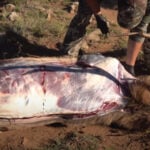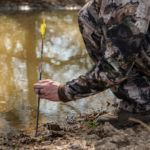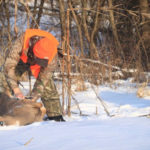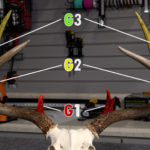You did your homework. You got the shot. Now what? The recovery is the most important part of the process. Without it, you have no prize.
Here’s what you need to do after the shot…
The First 30 Minutes
Recovering a deer begins the moment you let that arrow fly. Get a good visual on where the arrow hits and how the deer reacts after the shot, and never take your eyes off of the deer until it’s out of sight. The single most important thing you can do after the shot is take note of where you last saw the deer.
Keep in mind, things look differently from a treestand than they do on ground level. Distance, for one, can be deceiving. Things are often closer than they appear from an elevated platform. Before getting out of the stand, look for at least two good visual markers in the direction the deer ran. This will help you establish the blood trail more quickly. Finding first blood and establishing the trail is usually the hardest part. Upon impact, deer can panic and the first part of the trail can be erratic and hard to decipher, but if you have a direction to start looking, you’ll be a huge step closer to recovering the animal.
In this first few minutes after the shot, it’s also important to not rush into action. I resist the temptation to climb down right away and prefer to stay in my stand for at least 30 minutes to allow my nerves to settle and clear my head. Putting an arrow through a mature buck is an exciting moment, and there’s nothing we want more than to put our hands on the antlers, but mistakes happen when you hurry. So take your time and think it through before rushing in.
When to Trail
If there’s any doubt at all about where the arrow hit, back out and give it plenty of time, preferably overnight. Most bad hits are lost because hunters rush in and push the deer. But a deer’s instinct is to lay down when wounded, and if you allow enough time, it will expire.
Case in point, my second biggest buck to date was shot in the paunch. I had a 12-yard shot but the arrow deflected off a twig and actually hit the buck sideways. Somehow, once the arrow slammed up against the deer, the broadhead penetrated and the arrow kicked straight again. It was the strangest thing I’d ever seen. It was also one of the most disheartening because the buck scampered off but stopped about 50 yards out to look back in my direction before slowly walking off.
That was at 9AM. I let it go all day and started on the trail the following morning. My cousin and I ran out of blood after only 25 yards or so, but that was okay. We found the buck dead shortly after daylight no more than 75 yards from where I’d last seen it, and the chest cavity was still warm inside.
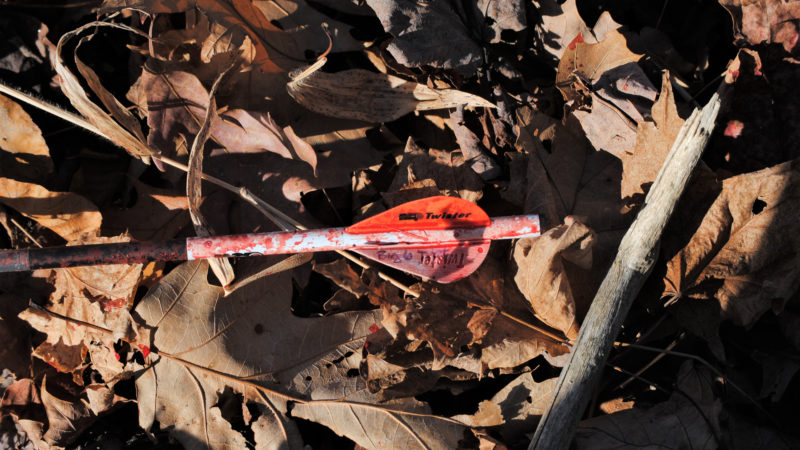
That was an extreme case as far as wait time goes, but I knew exactly where I’d hit the deer, which is a major key to knowing when and how to start the trail. When I exited my stand that morning, I walked in the opposite direction and circled back around toward the vehicle only after I was certain I had no chance at bumping the buck. In this particular case, I may have pushed the buck had I even walked up to look at my arrow stuck in the dirt.
Had I not known exactly where the deer had been hit, I would have cautiously approached the arrow and checked for blood, but only after waiting those 30 minutes in my stand. With arrow in hand, I’d then look for clues about how to proceed.
Generally speaking, a heart hit will leave bright red blood on your arrow. Sometimes the deer will mule-kick upon impact, but not always. Often, the deer will take off running with its body low to the ground, and they’ll rarely go more than 100-150 yards before dropping.
A double lung shot will leave bright, bubbly red blood on the arrow. However, the blood trail doesn’t always begin right away. Once it does, the trail should be very obvious. Again, 100-150 yards is about max distance that I’ve seen deer run when shot through both lungs. A single-lung hit is another story, and deer can easily run three or four times farther with this kind of hit.
Liver hits can be puzzling because the blood can start off looking really good, like a heart shot except with darker-colored blood, but the trail can get spotty fast. After the first 50 yards or so, it’s not uncommon to find only a drop or speck of blood every 10 feet, and sometimes every 10 yards. Make no mistake, though, this is a killing shot, and it requires patience and dedication to unravel the blood trail.
I have tracked liver-shot deer for myself and for friends no fewer than a half-dozen times in the past 15 years, and none of them were easy to recover, and all of them went several hundred yards before bedding down. In fact, I can think of three particular bucks that traveled over 800 yards, but the blood trail, no matter how sporadic, always led us to a dead deer.
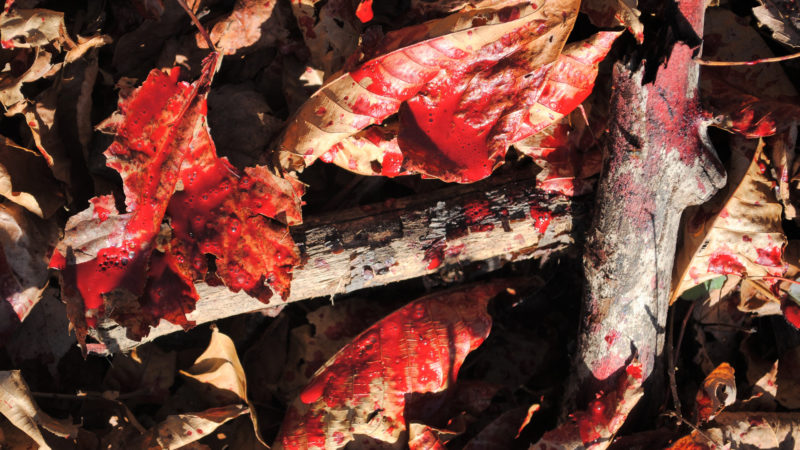
Paunch and intestine hits usually leave brownish-red blood, and sometimes green stomach matter, on the arrow. Gut shot deer can be incredibly difficult to find, but not impossible. You’re only chance at recovery is to back out and wait at least 12 to 16 hours before trailing. The good news is that gut-shot deer tend to lay down within 100-150 yards, and as long as you don’t attempt to pick up the trail too soon, it will die there or fairly close.
Body hits can be the most troubling because so many are non-lethal yet can produce a lot of blood at first. Most of the time, when I make a great shot, I know it. I see where the arrow hits and how the deer reacts. When we know we’ve made an obvious body hit (a ham or high shoulder shot, for instance), we often assume it’s a non-lethal hit, but that’s not always the case.
Yes, whitetails are amazing in their ability to survive, but they have the same network of veins and arteries running throughout their body as we do ours, and sometimes you can get lucky and sever one of these. For this reason, it’s important to follow up on every hit, even the ones that appear like just flesh wounds, to make sure they’re not lethal.
On the Trail
Not every wound starts pouring blood right away. Just because you don’t find good blood the first 25 yards or so doesn’t mean you didn’t make a good hit. As soon as an arrow passes through an animal, the skin shifts, and sometimes it can hold blood inside the chest cavity longer than usual. I’ve had instances where I didn’t start finding frothy lung blood for 50 yards or so.
How far a deer will run after the shot depends on many factors, the most important of which, in my opinion, is the attitude of the deer during the time of the shot. My quickest kills have come when the buck was relaxed and didn’t even know I was there. In fact, I shot one buck while it browsed, and it kept eating even after my arrow passed through its lungs. A few seconds later it stumbled and fell over.
Conversely, I’ve shot bucks that were chasing does, or that came in to a grunt or rattle, and had them run much farther than anticipated. In my experience, the more a buck’s adrenaline is pumping, the farther it is likely to run after the shot.
On a blood trail, after you’ve waited an appropriate amount of time, small details matter. Pay attention to kicked up leave or broken twigs and sticks. As you follow the trail, walk alongside of it rather than right on top of it. Always do your best to preserve the integrity of the trail in case you lose blood and have to backtrack a little bit.
It also helps to carry some sort of marking material, such as toilet paper or flagging (just be sure to take it down once you recover the deer), to help you establish a direction and for reference as you progress along the trail.
Changing perspective helps, too. When blood gets sparse, I’ll often get down on my hands and knees in places to inspect leaves for blood or even just to visualize the route the deer may have taken. Other times, especially if you’ve been on the trail for several hours, you need to take a break, eat a snack, and get refreshed.
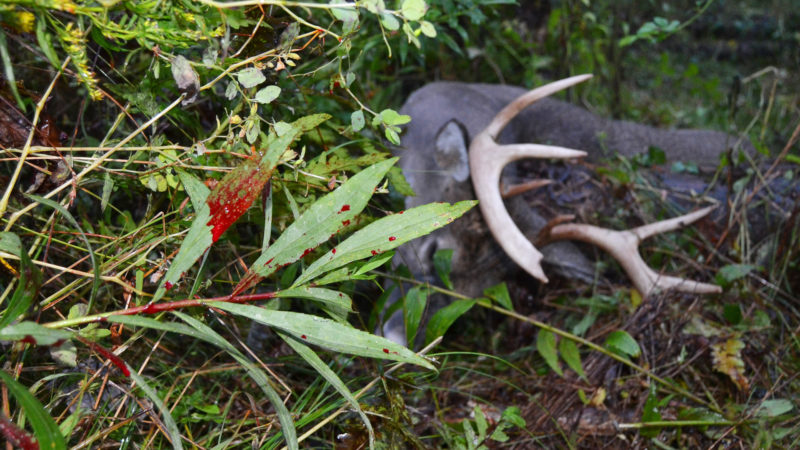
A friend and I once tracked a buck more than 800 yards over a four-hour period before the blood finally ran out. We looked for another hour with no luck and decided to go home for lunch. When we returned an hour later, we took a different route to the spot and came right up on the dead deer. It had fallen on the other side of a brush pile only 20 yards from the last spot of blood. The little break allowed us to regain focus and see things fresh again.
The best advice for recovering any animal you shoot is to be persistent. Don’t ever give up until you are 100% certain it cannot be recovered or that you made a non-fatal shot. And remember, no two blood trails are the same. I’ve made perfect hits that barely bled, and I’ve made what I thought were iffy shots and had the deer fall within sight. The best mindset is to approach every blood trail as if there’s a dead buck at the end of it.
Last, but not least, I’ve always found it best to limit the number of people who help me trail a deer to no more than two or three. Friends love to help, but it’s okay to tell them no, especially if they’re inexperienced trackers. Having too many people on a blood trail can turn into a party. Tracking deer should only be a party after the tracking is done.
Don’t be afraid to take charge of the situation and make sure everyone is contributing to the recovery rather than hindering. It’s your deer, after all, and it’s your prize. In the end, its recovery is all on you.

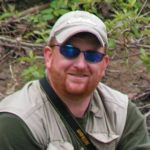 By
By 